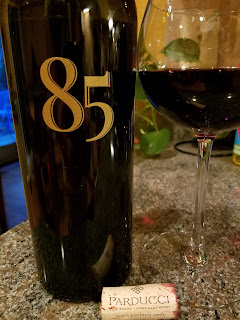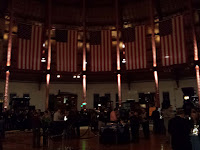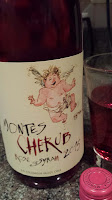 Earlier this month Wines of New Zealand hosted a seminar and tasting at the NZ Embassy titled New Zealand Wine Pure Discovery. The discovery manifested itself not only with New Zealand's two signature grapes, but also by the breadth of grape varieties and their differences across wine regions. Chardonnay, Pinot Gris, Riesling, and Gewurztraminer joined Sauvignon Blanc as reliable white wines whereas Syrah emerged to partner with Pinot Noir to express Kiwi red wines.
Earlier this month Wines of New Zealand hosted a seminar and tasting at the NZ Embassy titled New Zealand Wine Pure Discovery. The discovery manifested itself not only with New Zealand's two signature grapes, but also by the breadth of grape varieties and their differences across wine regions. Chardonnay, Pinot Gris, Riesling, and Gewurztraminer joined Sauvignon Blanc as reliable white wines whereas Syrah emerged to partner with Pinot Noir to express Kiwi red wines.
 As for the wine regions, they extend 1,000 miles from sub-tropical Northland down to Central Otago, home to the world’s most southerly vineyards. Marlborough is the flagship wine region, situated in the northeast corner of the South Island and experiencing a sunny and dry climate. Marlborough is notable for its Sauvignon Blanc as well as Pinot Noir, Chardonnay, and the Aromatics: Riesling, Pinot Gris and Gewürztraminer. There are also three sub-regions producing unique variations of these wine varietals -- the Wairau Valley, Awatere Valley, and Southern Valleys.
As for the wine regions, they extend 1,000 miles from sub-tropical Northland down to Central Otago, home to the world’s most southerly vineyards. Marlborough is the flagship wine region, situated in the northeast corner of the South Island and experiencing a sunny and dry climate. Marlborough is notable for its Sauvignon Blanc as well as Pinot Noir, Chardonnay, and the Aromatics: Riesling, Pinot Gris and Gewürztraminer. There are also three sub-regions producing unique variations of these wine varietals -- the Wairau Valley, Awatere Valley, and Southern Valleys.Hawke’s Bay is New Zealand's second largest wine region with it's temperate climate located in the southeast of the North Island. Red Bordeaux and Syrah grapes thrive in the porous soils particularly in the Gimblett Gravels. Chardonnay, Sauvignon Blanc, Pinot Gris, and Pinot Noir are planted in cooler regions such as coastal areas, river valleys, and Central Hawke's Bay.
 Pure Discovery also featured wines from Nelson (north-central South Island), Central Otago (southerly South Island), Northland (extreme north North Island), Martinborough (extreme southeast North island), and North Canterbury (east-central South Island). This later region is home to Mt. Beautiful, producers of a wide range of delicious wines from Pinot Noir and Pinot Gris to Sauvigon Blanc, Riesling, and Chardonnay. Nelson was well represented by the excellent Neudorf Tom's Block Pinot Noir 2014 ($22) which combines weightiness with bright dark fruit, earth, and slight spices. Nelson is also home to the unique styles of Nelson's Mahana -- notable for their funky Feral Lahar Sauvignon Blanc Nelson ($35), Mahana Nelson Pinot Noir Rosé 2016 ($42), and complex Mahana Clays & Gravels Woolly’s Corner & Cornelia’s Nine Pinot Noir 2014 ($65). And in Martinborough, Craggy Range showcased an elegant and rounded Te Muna Road Vineyard, Martinborough Sauvignon Blanc 2016 ($21).
Pure Discovery also featured wines from Nelson (north-central South Island), Central Otago (southerly South Island), Northland (extreme north North Island), Martinborough (extreme southeast North island), and North Canterbury (east-central South Island). This later region is home to Mt. Beautiful, producers of a wide range of delicious wines from Pinot Noir and Pinot Gris to Sauvigon Blanc, Riesling, and Chardonnay. Nelson was well represented by the excellent Neudorf Tom's Block Pinot Noir 2014 ($22) which combines weightiness with bright dark fruit, earth, and slight spices. Nelson is also home to the unique styles of Nelson's Mahana -- notable for their funky Feral Lahar Sauvignon Blanc Nelson ($35), Mahana Nelson Pinot Noir Rosé 2016 ($42), and complex Mahana Clays & Gravels Woolly’s Corner & Cornelia’s Nine Pinot Noir 2014 ($65). And in Martinborough, Craggy Range showcased an elegant and rounded Te Muna Road Vineyard, Martinborough Sauvignon Blanc 2016 ($21).
Central Otago was populated by a plethora of outstanding wines starting with the elegant Maude Pinot Noir 2015 ($25) and the saline driven Amisfield Sauvignon Blanc 2016 ($21). The Loveblock Central Otago Pinot Noir 2015 ($30) and clean Mud House Central Otago Pinot Noir 2015 ($15) are two tasty options. However the best in show for Central Otago was Felton Road who poured two fantastic Chardonnays in the Felton Road Chardonnay Bannockburn Central Otago 2014 ($34) and its companion the Felton Road Chardonnay Block 2 Bannockburn Central Otago 2014 ($46). Simply delicious. Felton Road also poured the sagy Dry Riesling Central Otago 2015 ($26) and aged Calvert Pinot Noir Bannockburn Central Otago 2013 ($43) and Calvert Pinot Noir Central Otago 2012 ($54). These wine labels are a mouthful.
Moving back to the major wine regions, the Trinity Hill Syrah Gimblett Gravels Hawkes Bay 2014 ($28) and Gimblett Gravels Hawkes Bay The Gimblett 2014 ($38) are simply outstanding. Trinity Hills was also pouring a lean Hawkes Bay Sauvignon Blanc 2015 ($17) and clean Hawkes Bay Pinot Noir 2015 ($18). And the Geissen Hawkes Bay Chardonnay 2016 ($15) is a fresh, value driven wine.
 Geissen also represented Marlborough with dignity with the The Fuder Clayvin Vineyard Marlborough Chardonnay 2013 ($65); but you can find more value wines in Marlborough through Brancott Estate, providing well made wines from $10 to $20. I wanted to note the Lawson's Dry Hills Marlborough Gewürztraminer 2014 ($25) which nails the style providing the spicy aromatics and flavors with abundant acids to balance the sugar. Nicely done. As for Marlborough Sauvignon Blanc, the lasting impression is that winemakers are moving away from the lemongrass profile towards the tart, lean and clean style of the Geissen Sauvignon Blanc 2016 ($11) or the tropical velvety style as the Sacred Hill Marlborough Sauvignon Blanc ($17). Cheers to New Zealand Wine Pure Discovery.
Geissen also represented Marlborough with dignity with the The Fuder Clayvin Vineyard Marlborough Chardonnay 2013 ($65); but you can find more value wines in Marlborough through Brancott Estate, providing well made wines from $10 to $20. I wanted to note the Lawson's Dry Hills Marlborough Gewürztraminer 2014 ($25) which nails the style providing the spicy aromatics and flavors with abundant acids to balance the sugar. Nicely done. As for Marlborough Sauvignon Blanc, the lasting impression is that winemakers are moving away from the lemongrass profile towards the tart, lean and clean style of the Geissen Sauvignon Blanc 2016 ($11) or the tropical velvety style as the Sacred Hill Marlborough Sauvignon Blanc ($17). Cheers to New Zealand Wine Pure Discovery.











































